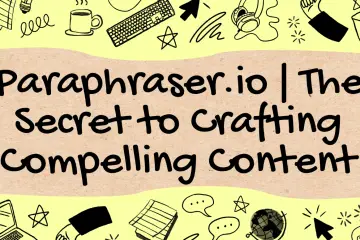What about the text that needs to be written? The intern can write on the side. That goes fast!
Of course, you can see it that way. Then you give away immense potential. Because well-written texts make the difference between no interest and a won conversion. Poor texts, on the other hand, ensure that your content is simply scrolled over.
But how do you write amazing texts? How do you create content that captivates, engages, and inspires from mere words? In this article, we give you 9 tips for writing better texts.
What is the difference between texts and writing?
Before we get to the actual tips, it makes sense to make a distinction again. After all, it should first be clear what exactly is to be understood by texts. A distinction to writing is suitable for this.
Writing basically refers to pure activity. Whenever you write down a word, be it with a pen, typewriter, or laptop, you are writing.
Creating marketing texts, on the other hand, behaves differently. It is a special form of writing.
But what constitutes advertising texts anyway? Basically, it is a way of using text. They fulfill a clear, purposeful purpose (e.g. sales, image, information, customer loyalty…) and every word is subordinate to this purpose.
Whoever writes texts does not exercise any artistic activity as happens when writing novels. Instead, this person creates purposeful texts that have a clear goal and are supposed to achieve them in the best possible way.
In line with this, texts are also seen as a kind of written sales pitch in which copywriters anticipate all possible counterpoints and questions with clear formulations and thus ultimately persuade them to take action.
Only through this definition is it possible to understand why there are better and worse texts. Better texts are characterized by the fact that they ultimately serve their purpose better. This can often even be quantified (e.g. by measuring conversions, clicks, etc.). And that’s what it’s all about when you try to optimize your texts. They should become more useful and therefore more successful.
9 tips to help you write better texts
1. Understand the product / the service / the company
Those who write must learn. Learn a lot. After all, it is important to constantly think about new companies and their services and products. Appropriate care is necessary because this is the only way you can really understand the respective product. A corresponding research time is therefore absolutely necessary.
Only if you have really penetrated the product, you can convey the content accordingly. After all, it is about purposeful communication. For this, it is essential that you can assess exactly which advantages of the product fit the respective target audience and where there may be queries.
Copywriters who are permanently employed by a company naturally have an advantage here because they can specialize in the respective topic. External copywriters from agencies are strongly dependent on a good briefing and additional research. In this case, a correct understanding of the product can only be achieved through close coordination between the company and the copywriter.
2. Get to know the target audience
How do you write in a targeted manner if you don’t even know who you are writing for? Not at all! After all, a text for a specialist audience of scientists would sound completely different than one for a new chewing gum that is particularly interesting for children and young people thanks to its fruity taste.
In short: You have to know the target audience because you can only address this target group appropriately if you know who you are writing for. This also means that you acquire the particular language features.
You have to understand what moves these people, where the problems lie, what their wishes are, and how they speak. Without target group analysis and appropriate knowledge, you end up writing in the dark.
3. Harness the power of psychology
There are countless publications on (sales) psychology. And if you want to write texts, you should have at least basic knowledge in this area. There is one main reason for this: Nobody wants to deal with advertising texts and marketing content.
After all, it’s not about the latest novel by your favorite author or a magazine you subscribe to. Most of the time, we come across advertising texts involuntarily and are usually not very interested in dealing with them. In short: All your texts compete with a gigantic mass of content on the web.
It is equally important that you learn how to use a lifeline to pull people ashore in this flood of information. To do this, consider five reasons we consume content:
They are easy to consume. No one wants to go through boxed sentences and text deserts torment. Therefore, text must always be well structured, precisely worded, and kept crisp. That’s the only chance of being read at all.
They contain familiar things from our living environment. This is where knowledge of the target group comes into play again. We humans like to pay attention when we discover something familiar. Accordingly, it is important to process experiences from the living environment of the target group.
You communicate a clear benefit. We always want to make our lives as easy as possible. That is why we listen carefully and read whenever a text promises us actual benefit and relief.
They stimulate curiosity. Excitement through cliffhangers, promising headlines, teasers of a problem – all this and much more makes people curious. And if you are curious, read the next block of text as well. And the one after. Attention: Please do not fall into blunt click-baiting …
They arouse fear or build up pressure. Pain often outweighs positive feelings. That’s why fear is a powerful driver when it comes to moving us to action. It is not without reason that many special offers work with limitations so potential customers are afraid of missing out on the special offer. The following applies here: be careful with this emotion. After all, your target group should associate something positive with your product and not just strike out of fear or pressure. However, throwing at least a spark in that direction can help here and there.
In addition, there are countless other theories and research on the buying behavior of people. Of course, this also includes the customer journey. Acquire as much experience as possible in these areas over the years. Because he will definitely help you with the texts.
4. Translate Features into Benefits
No one wants to read lengthy technical details. At least not when you first come into contact with a product or service. Instead, we want to have a clear question answered: What’s in it for me?
This may sound selfish at first, but it’s that simple. People want to know what use a product or service brings them. And maybe even why it has to be the product of company A and not that of company B.
That’s a big challenge for the texts. Because it is now a matter of generating real advantages from mere properties and characteristics. This is where knowledge about the target group, product, and psychology comes together and ideally unfolds its power. Would you like some examples?
Are the new hiking shoes characterized by being extraordinarily light? Then you can climb any mountain without getting tired feet. It may even be a feeling of freedom, like exploring the world barefoot.
Does the new television model have an even larger screen? Do not bore the target group with boring information, but promise a real cinematic experience for the living room at home. The size of a screen, the sharpness of a modern TV.
Does the new, even stronger energy drink contain more taurine, more caffeine, and more sugar? Well, that’s a health risk… But it would probably be a case for a reference to even more power in everyday life and more energy for everyone who loves the extreme.
The principle should be clear. So if you have product properties in front of you, then always think about what concrete benefit the target group has from it. Of course, this will not be possible for all product properties. So when communicating, focus on the clear USPs that bring real benefits. Mandatory technical information can still be placed on a website in a fold-out tab or in a download.
5. Speak to the senses
We, humans, are sensual beings. In this case, it is meant literally. Because in our entire perception we depend on our five senses – seeing, hearing, smelling, tasting, and touching.
Texts always work particularly well when as many of these senses as possible are addressed. That doesn’t mean that you should include a miracle tree for the right smell in your sales letter. Although that can also be a sensible idea, depending on the situation.
Rather, it is about stimulating the senses in the text. Let’s take a mountain bike as an example. First of all, it’s about action in the mountains. What possibilities are there to appeal to the senses?
- Sounds from nature (animals, water) and cracking branches or stones under the wheels
- The very special smell of nature
- Wonderful landscapes to be seen on the next bike ride
- The feeling of the handlebars and the saddle
- Of the taste of freedom
Of course, you shouldn’t overdo it. New tax software is only a sensory experience for very few people, but rather a (ideally useful) necessity and relief. But whenever possible, you should include the senses when writing. Because that way the target group gets a real feeling for your product when reading.
6. Dare to use metaphors and storytelling
We, humans, love stories and prefer to process information when it is embedded in a pictorial context. It is not without reason that digital storytelling is one of the major topics in content marketing. The special emotionality of stories makes things more tangible and keeps them in our memories longer.
Don’t you think so? Which variation of advertising a hair restorer product would appeal to you more:
A sober listing of the product properties: A hair restorer increases the number of hair roots by up to five per square millimeter.
Communication of a clear benefit: The hair restorer super growth gives you reliably full hair.
The gripping success story of a testimonial: Justin struggled with hair loss even when he was at school. As a result, he faced bullying. He was very unhappy with his life and tried many solutions. Until he had success with the hair restorer. Now he has renewed confidence and is happy.
Of course, you won’t always have testimonials and big stories to fall back on. But even on a small scale, there are possibilities to orientate oneself on the classic story elements. You’ll find more about it here.
Another possibility for pictorial texts is metaphors. They particularly facilitate the introduction to the text and, if they are taken up again at the end, create a nice framework for the content. Use e.g. Vocabulary from specific areas to give products specific properties.
For example, insurance or financial products are often illustrated with seafaring (take the rudder, enter the safe haven, change the rudder, navigate correctly). Other products may be convincing in a dynamic sports context (starting gun, finish line, full steam ahead…).
Of course, the same applies here: Don’t overdo it. Never lose yourself in a metaphor or word world. Because such gimmicks are particularly suitable as an attention grabber that briefly holds the target group in the stormy flood of information. A text with 1000 words full of a seaman’s vocabulary is rather daunting and confusing.
7. Surprise you with language
Just because writing isn’t an artistic activity doesn’t mean the lyrics aren’t artistic may be written. Because small subtleties and unusual formulations can do a lot to inspire the target audience.
So dare to let the language run free. See when you can give people a little gift in the form of language.
8. Pay attention to a pleasant speech rhythm
Language has its own Rhythm. It flows, depending on the respective formulations. As you may have noticed, the rhythm of speech depends on the length of words and sentences. The shorter the sentences and words, the choppier and faster the beat. The longer and more extravagant formulations are, the calmer and more settled they appear.
Use this knowledge of the speech rhythm. Write as varied as possible to enable a pleasant flow of reading. At the same time, you can consciously try to build up tension that comes to a head with sentences that get shorter and shorter. Overall, make sure that the speech rhythm goes well with your product or service.
A wellness spa can for example be described with sentences that are as euphonious as possible and seem excessive. When describing a soccer goal, can be described in a more hectic, energetic, and choppy way.
9. View the writing as a (joint) process
Nobody just writes a text and then it’s done. Often the first draft is even horrible and far from readable. That’s not bad. Because writing is always a process that takes time and several drafts.
So don’t try to make everything perfect right from the first draft. This will only slow you down and prevent you from getting a sentence down. Instead, just start writing and let the language run free.
During the revision, you can smooth everything, structure it better and thus arrive at the perfect text bit by bit. Incidentally, this also includes correction and feedback loops with other people.
If you work in a company, it will often be the specialist department, product development, or colleagues as well as colleagues from marketing. If you work as an external service provider, the text will be refined in cooperation with the customers.
Without such Agreements and correction loops will never result in a perfect text. Everyone involved should get rid of the misconception of the perfect first draft as quickly as possible in order to finally get the writing process going.
Summary: 9 Tips for writing better texts
- Understand the product/service/company. This is the only way you can communicate the benefits accordingly.
- Get to know the target audience with their living environment, their desires, goals, and their language. Then you can reach them specifically.
- Use the power of psychology. This is how you gain the attention of your target group.
- Translate properties into clear benefits. In the end, it is only important that the product brings benefits to the target group.
- Speak to the Senses. In this way, the product becomes perceptible and anchors itself deeply in the memory.
- Dare to use metaphors and storytelling. Because visual language and stories attract our attention and memorize them.
- Surprise with language. This is how you provide small highlights in your text and keep the target group engaged.
- Ensure a pleasant reading flow. To do this, take your knowledge of the speech rhythm to heart and adapt it accordingly.
- Understand writing as a common process. Discard perfection and benefit from joint correction loops. Just try our tips piece by piece for yourself.
You will see that you will get better and better at writing. At first, this may only be a subjective impression, but in the long run, better texts are reflected in more successful metrics. You will learn step by step how to optimize your content and formulate convincing texts from mere words.








